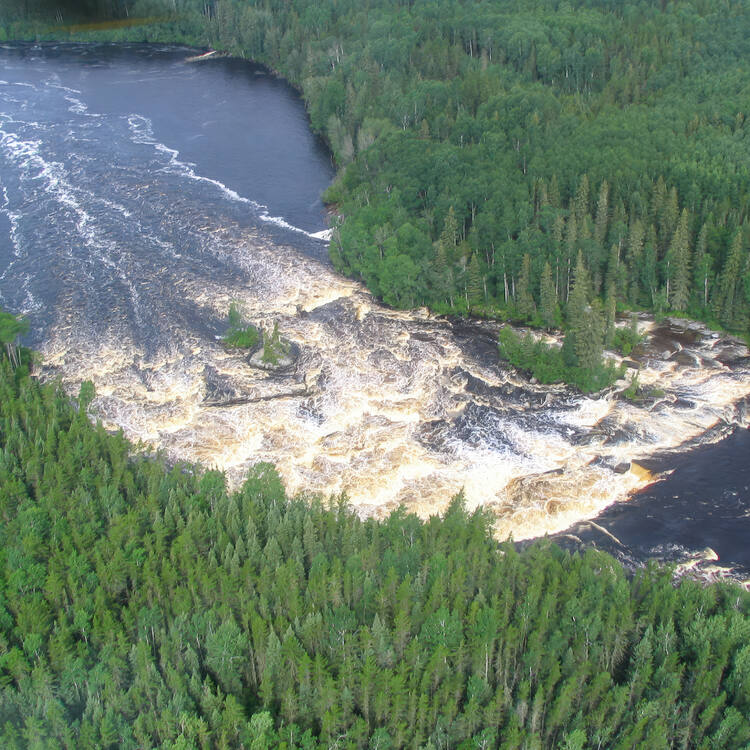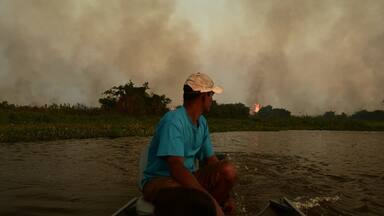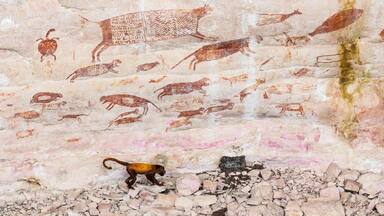Pimachiowin Aki
Pimachiowin Aki
Pimachiowin Aki ('The Land That Gives Life') is a landscape of rivers, lakes, wetlands, and boreal forest. It forms part of the ancestral home of the Anishinaabeg, an indigenous people living from fishing, hunting and gathering. The site encompasses the traditional lands of four Anishinaabeg communities (Bloodvein River, Little Grand Rapids, Pauingassi and Poplar River). It is an exceptional example of the cultural tradition of Ji-ganawendamang Gidakiiminaan ('keeping the land'), which consists of honouring the gifts of the Creator, respecting all forms of life, and maintaining harmonious relations with others. A complex network of livelihood sites, habitation sites, travel routes and ceremonial sites, often linked by waterways, provides testimony to this ancient and continuing tradition.
Description is available under license CC-BY-SA IGO 3.0
Pimachiowin Aki
Paysage forestier de rivières, émaillé de lacs, de zones humides et de forêts boréales, Pimachiowin Aki (« La terre qui donne la vie ») fait partie des territoires ancestraux des Anishinaabeg, un peuple autochtone vivant de la pêche, de la chasse et de la cueillette. Il englobe des portions de territoires de quatre communautés Anishinaabeg (Bloodvein River, Little Grand Rapids, Pauingassi et Poplar River). Il s'agit d'un exemple exceptionnel de la tradition culturelle Ji-ganawendamang Gidakiiminaan (« garder la terre ») qui consiste à honorer les dons du Créateur, respecter toute forme de vie et maintenir des relations harmonieuses avec autrui. Un réseau complexe de sites de subsistance, de sites d’habitation, de voies de déplacements et de sites cérémoniels, généralement reliés par des voies navigables, témoigne de cette tradition ancienne et continue.
Description is available under license CC-BY-SA IGO 3.0
غابة
source: UNESCO/CPE
Description is available under license CC-BY-SA IGO 3.0
皮玛希旺·阿奇
皮玛希旺·阿奇(意为“赋予生命的土地”)是一片有众多河流穿过,湖泊、湿地和北方森林交错的森林景观。这里是北美印第安人族群Anishinaabeg的祖居之地的一部分,该族群以捕鱼、狩猎和采集为生。该地区共有4个Anishinaabeg社区(Bloodvein River、Little Grand Rapids、Pauingassi和Poplar River)的传统领地。这片遗产地是“保有土地”文化传统的典范,其组成包括纪念造物主的恩赐,尊重一切形式的生活,及与他人保持和睦的关系。多由水路连接的活动地区、居住地点、通行路线和仪式地点组成的复杂网络充分体现了这一传统。
source: UNESCO/CPE
Description is available under license CC-BY-SA IGO 3.0
Пимачиовин Аки
Пимачиовин Аки («Земля, дарующая жизнь») представляет лесной ландшафт, пересеченный реками, покрытый озерами, водно-болотными угодьями и бореальными лесами. Пимачиовин Аки входит в число исконных территорий анишинабегов – местного коренного народа, живущего за счет рыбной ловли, охоты и собирательства. Пимачиовин Аки охватывает часть территорий четырех общин анишинабегов: бассейны рек Бладвейн и Поплар, Литл-Гранд-Рапидс, Поингасси). Объект является выдающимся примером культурной традиции Ji-ganawendamang Gidakiiminaan («сохранения земли»), заключающейся в почитании даров Создателя, уважении ко всем формам жизни и поддержании гармоничных отношений с другими людьми. Эта традиция отражена в ландшафте сложной системой средств к существованию, структурой населенных пунктов, дорог и церемониальных мест, как правило, связанных между собой внутренними водными путями.
source: UNESCO/CPE
Description is available under license CC-BY-SA IGO 3.0
Pimachiowin Aki – “La tierra que da la vida”
Sitio cubierto de bosques boreales, surcado por ríos, constelado de lagos y humedales, Pimachiowin Aki, la “tierra que da la vida” en la lengua de los anishinaabeg, forma parte de los territorios ancestrales de este pueblo indígena que vive de la caza, la pesca y la recolección. El sitio agrupa porciones de los territorios de cuatro comunidades anishinaabeg: Bloodvein River, Little Grand Rapids, Pauingassi y Poplar River. La compleja red formada por los sitios dedicados a la subsistencia, la vivienda y las ceremonias cultuales, así como por los itinerarios principalmente fluviales y lacustres que los enlazan, constituye un paisaje excepcional en el que se ha materializado la inmemorial tradición indígena denominada ji-ganawendamang gidakiiminaan (“conservar la tierra”), consistente en honrar los dones del Creador, respetar todas las formas de vida y mantener relaciones armoniosas con el prójimo.
source: UNESCO/CPE
Description is available under license CC-BY-SA IGO 3.0
Outstanding Universal Value
Brief synthesis
Pimachiowin Aki, part of the ancestral lands of the Anishinaabeg people at the headwaters of the Berens, Bloodvein, Pigeon and Poplar rivers, is an exceptional example of cultural tradition of Ji-ganawendamang Gidakiiminaan (Keeping the Land) that involves honouring the Creator’s gifts, observing respectful interaction with aki (the land and all its life), and maintaining harmonious relations with other people. The forest landscape, dissected by free-flowing rivers, lakes and wetlands, includes portions of the lands of four Anishinaabe First Nations: Bloodvein River, Little Grand Rapids, Pauingassi, and Poplar River First Nations and extends to 2,904,000 hectares. It encompasses slightly less than a quarter of the lands occupied by Anishinaabeg peoples.
The Anishinaabe world view of a symbiotic relationship between people and nature attributes animacy to objects in the natural world giving meaning to peoples’ existence in this environment over time and through the seasons. Today, within Pimachiowin Aki, Anishinaabeg are based in four small permanent Anishinaabe communities, and they are highly mobile and make use of waterways and a complex network of often impermanent interlinked sites, routes and areas in this extensive natural landscape of multi-layered forest, to harvest animals, plants and fish, consistent with their traditional practices.
Ancient and contemporary livelihood sites, habitations and processing sites, travel routes, named places, trap lines, widely dispersed across the landscape, while being sacred and ceremonial sites, reflect the way they, and their Indigenous ancestors, have made use of this and adjacent landscapes for over 7,000 years. Pimachiowin Aki thus expresses an outstanding testimony to the beliefs, values, knowledge, and practices of the Anishinaabeg that constitute Ji-ganawendamang Gidakiiminaan; the persistence of Anishinaabe customary governance ensures continuity of these cultural traditions across the generations.
Through the cultural tradition of Ji-ganawendamang Gidakiiminaan, Anishinaabeg have for millennia lived intimately with this special place in the heart of the North American boreal shield. Pimachiowin Aki is a vast area of healthy boreal forest, wetlands, lakes, and free-flowing rivers. Waterways provide ecological connectivity across the entire landscape. Wildfire, nutrient flow, species movements, and predator-prey relationships are key, naturally functioning ecological processes that maintain an impressive mosaic of ecosystems. These ecosystems support an outstanding community of boreal plants and animals, including iconic species such as Woodland Caribou, Moose, Wolf, Wolverine, and Loon.
Criterion (iii): Pimachiowin Aki provides an exceptional testimony to the continuing Anishinaabe cultural tradition of Ji-ganawendamang Gidakiiminaan (Keeping the Land). Ji-ganawendamang Gidakiiminaan guides relations between Anishinaabeg and the land; it is the framework through which the cultural landscape of Pimachiowin Aki is perceived, given meaning, used and sustained across the generations. Widely dispersed across the landscape are ancient and contemporary livelihood sites, sacred sites and named places, most linked by waterways that are tangible reflections of Ji-ganawendamang Gidakiiminaan.
Criterion (vi): Pimachiowin Aki is directly and tangibly associated with the living tradition and beliefs of the Anishinaabeg, who understand they were placed on the land by the Creator and given all they need to survive. They are bound to the land and to caring for it through a sacred responsibility to maintain their cultural tradition of Ji-ganawendamang Gidakiiminaan (Keeping the Land). This involves ceremonies at specific sites to communicate with other beings, and respect for sacred places such as pictograph sites, Thunderbird nests, and places where memegwesiwag (little rock people) dwell, in order to ensure harmonious relations with the other spirit beings with whom Anishinaabeg share the land, and to maintain a productive life on the land.
The beliefs and values that make up Ji-ganawendamang Gidakiiminaan are sustained by systems of customary governance based on family structures and respect for elders, and through vibrant oral traditions that are tangibly associated with intimate knowledge of the land through named places that serve as mnemonic prompts, including locations of resources, travel routes, and the history of Anishinaabe occupation and use.
The size of Pimachiowin Aki and the strength of these traditions make it an exceptional example of a belief that can be seen to be of universal significance.
Criterion (ix): Pimachiowin Aki is the most complete and largest example of the North American boreal shield, including its characteristic biodiversity and ecological processes. Pimachiowin Aki contains an exceptional diversity of terrestrial and freshwater ecosystems and fully supports wildfire, nutrient flow, species movements, and predator-prey relationships, which are essential ecological processes in the boreal forest. Pimachiowin Aki’s remarkable size, intactness, and ecosystem diversity support characteristic boreal species such as Woodland Caribou, Moose, Wolf, Wolverine, Lake Sturgeon, Leopard Frog, Loon and Canada Warbler. Notable predator-prey relationships are sustained among species such as Wolf and Moose and Woodland Caribou, and Lynx and Snowshoe Hare. Traditional use by Anishinaabeg, including sustainable fishing, hunting and trapping, is also an integral part of the boreal ecosystems in Pimachiowin Aki.
Integrity
Pimachiowin Aki is of sufficient size to encompass all aspects of Anishinaabe traditional livelihood activities, customary waterways, traditional knowledge of the landscape and seasonal rounds of travel, for hunting, trapping, fishing and gathering, and sacred sites, (although some of these extend beyond the boundaries), and includes sufficient attributes necessary to convey its value. The key attributes are considered to be highly intact. Patterns of traditional use (fishing, gathering, hunting and trapping) and veneration of specific sites by the Anishinaabe First Nations have developed over millennia through adaptation to the dynamic ecological processes of the boreal forest, and appear to be ecologically sustainable.
Pimachiowin Aki also contains all the elements necessary to ensure continuity of the key ecological processes of the boreal shield. The robust combination of First Nation and provincial protected areas forms the largest network of contiguous protected areas in the North American boreal shield. The vast size of the property provides for ecological resilience, especially in the context of climate change, and extensive buffer zones further contribute to integrity. These provide as well a sufficiently large area to enable the continuity of the living cultural tradition of Ji-ganawendamang Gidakiiminaan.
The cultural and natural values of Pimachiowin Aki are free from the adverse effects of development and neglect. The very limited infrastructure includes a few power lines, seasonally functional winter roads, and the all-season East Side Road (under construction). All of these are subject to numerous protections concerning development. The whole property is protected from commercial logging, mining, and hydroelectric development, and all its waterways are free of dams and diversions.
Pimachiowin Aki exemplifies the indissoluble bonds between culture and nature. It is therefore vital that the integrity of customary governance and oral traditions be maintained in order to ensure continuity of the cultural tradition across generations and a continuation of the current high levels of stewardship which are evident within the property. With the free engagement and willing agreement of neighbouring First Nations, ecological integrity could be further enhanced by progressive addition of areas of high conservation value adjacent to the inscribed property.
Authenticity
The ability of the landscape to reflect its value relates to the robustness of the cultural traditions that underpin spiritual, social and economic interactions and their ability to function fully in relation to the adequacy of natural resources, as well as to the necessary freedom of movement needed for communities to respond to changing seasons and environmental conditions. Sites in the landscape (such as archaeological sites, sacred sites, waterways and hunting and harvesting sites) remain in use to a degree that the landscape reflects adequate interactions over time, and relates to the ability of the Anishinaabe communities to maintain their traditions across their vast landscape. In order to maintain authenticity, sustaining the resilience of these traditions will need to be an overt part of the management of the property.
Protection and management requirements
First Nations have played the leading role in defining the approach to protection and management of Pimachiowin Aki. The four First Nation communities have strong traditional mechanisms of protection that draw from the cultural tradition of Keeping the Land as articulated in the First Nations Accord, 2002. Protection and management of the property are achieved through Anishinaabe customary governance grounded in Ji-ganawendamang Gidakiiminaan, contemporary provincial government law and policy, and cooperation among the four First Nations and two provincial government partners. A memorandum of agreement between the provincial governments provides assurances about protection and management of the property. The Pimachiowin Aki partners share a commitment to work together to safeguard the Outstanding Universal Value of Pimachiowin Aki for present and future generations.
The vast majority (c. 99.98 %) of the property is protected under provincial legislation that recognizes the designated protected areas identified in the First Nation land use plans and provincial parks legislation (provincial parks legislation applies to three provincial protected areas). There is supportive “enabling legislation” at federal and provincial levels relating to protecting species at risk, regulating resources and development, as well as to public consultation on proposed land-uses. The four First Nation settlements make up the remainder of the World Heritage area (c. 0.02 %) and are covered by Canada’s Indian Act. Additional national and provincial legislation applies, for example, to Lake Winnipeg, several rivers and with regards to specific terrestrial and aquatic species. In most cases the protection is primarily for nature conservation but the provincial park legislation allows cultural heritage to be taken into account. The entire World Heritage area is protected from all commercial logging, mining, peat extraction, and the development of hydroelectric power, oil and natural gas. Similar protections cover the management areas of the buffer zone.
First Nations and provincial partners have created the Pimachiowin Aki Corporation and developed a consensual, participatory governance structure, financial capacity, and management framework for the property. The Pimachiowin Aki Corporation acts as a coordinating management body and enables the partners to work in an integrated manner across the property to ensure the protection and conservation of all natural values. The property has an overall management plan that brings together key elements of the four First Nation land use plans and the park management plans of the provincial protected areas. The management plan and series of legal protections uphold the practices associated with the traditional land management system embedded in Ji-ganawendamang Gidakiiminaan. The management plan is a high level plan and it relates to more detailed management plans and land use strategies that are in place for the four First Nations’ areas.
The management framework is designed to meet potential challenges in the protection and conservation of the property, such as monitoring and mitigating the potential impacts of the construction of an all-season road [East Side Road] over the next 20 to 40 years. Climate change is also a challenge that requires adaptive management. A conservation trust fund has been set up to secure long-term sustainable financing for the management of the property.
The management plan could be made more proactive and strengthened to address socio-economic issues by promoting diversification and support for local economies, and through the development of action plans for specific aspects such as visitor management, to ensure it is sustainable in terms of the landscape and its spiritual associations, is under the control of the communities, and offers benefits to them. The effectiveness of the complex and integrated management system should be carefully monitored over time.




